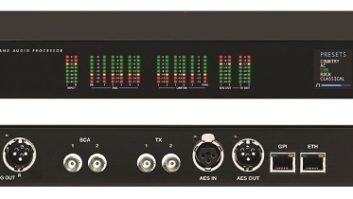Remote Equipment Reset Without an IP Connection
Jul 1, 2012 1:30 AM, By Jerry Olson, CSRE
We’ve all had experience with a piece of equipment that ceases to function. In the past, this meant a trip to the mountain, perhaps to merely power cycle the offending unit. More than once, I’ve had to reboot a digital receiver that sounded like an engine running at 2500 RPM.
Power strips have been developed that allow power cycling of individual outlets via an Ethernet connection. But what do you do when an IP connection is not available?
Many remote control units use either a control tone or a DTMF code to activate relays at the remote site. The units I’ve worked with specifically warn against switching 120Vac through the on-board relays mainly due to the danger of exposed line voltage at the connection points. This then requires the use of an external relay (in an enclosure) and a power supply to drive it.
This outlines how to construct a simple self-contained remote control relay interface that will allow you to remotely power cycle your recalcitrant equipment with an external relay closure of less than 20Vac at 35mA.
The unit is a dual reset box with two sets of transformers and relays. The shorting link on the hot side of the duplex outlet was removed to allow the two outlets to operate independently. The tab on the neutral side was left in place. If only one reset is desired, omit the second transformer and relay.

The schematic. Click to enlarge.
The operation of the reset box relies on the fact that the impedance of the primary winding of an unloaded transformer is very high. This is especially true for current-limited doorbell transformers that are meant to be energized 24/7/365. An added advantage of the doorbell transformer is that it is UL listed.
The theory of operation is simple: The primary of the doorbell transformer is wired in series with the relay coil. The tiny bit of current flowing in this circuit is not enough to pull in the relay. If the transformer secondary is shorted (say through your remote control) the impedance drop is reflected in the transformer’s primary and the relay closes. An outlet mounted in the box is wired so the power to the outlet is interrupted by the normally closed contacts of the relay when activated.
When the short is removed on the secondary, the primary impedance rises and the relay drops out. A 10kO shunt resistor across the relay coil will insure that the relay will drop out once the short on the secondary is removed. The dissipation in this resistor should be less than 1W, but the use of a 2W resistor would cover the unlikely occurrence of the relay coil going open.
Construction is fairly straightforward. Most importantly, build this reset box in a tall 4 x 4 box. The use of a raised cover to mount the duplex outlet will allow extra clearance for the relays and wiring below. The doorbell transformers will mount directly into 1/2″ knockouts on the box. Plan ahead so that the correct size knockouts are where you want them. Be sure that all of the green wires are bonded to the box. The NEC requires the duplex outlet to be grounded to the box with a jumper. Securely attach the relays to the box somewhere off to the side. I used a quick-setting epoxy for this purpose. Connect the source black wire to the normally closed contact on each relay. Connect the wiper contact of each relay to its respective outlet. This will remove the source ac from the outlet without it appearing on the unused normally open contact. It’s a small point, but it might prevent an unexpected short. The only other weird thing about the wiring is that the white leads of the transformers will not be connected to the neutral but will, instead, connect to the hot side of the relay coil.
Parts list:
� (1 or 2) Radio Shack 275-0217 DPDT relay. Contacts rated 10A
� (1 or 2) IQ America DT-1610A 16V/10W transformer
� (1 or 2) 10kO resistor 2W
� 4 x 4 tall electrical box
� 4 x 4 raised duplex cover plate
� Duplex outlet
� Power cord
� Cable clamp suitable for the power cord used

The finished project.
You may find many of these items in your junk box. Most of us have a few salvaged power cords cluttering up the bench. I happened to have a box of 5W resistors, so I used those. The dual reset box as shown was built for under $50 using transformers bought at a local home center. Much better pricing can be found online.
Olson is chief engineer of Spokane Public Radio, Spokane, WA.
July 2012
AVB for radio, a tour of WZIP-FM, update on translator rules, and Field Reports on the Inovonics David IV and Audio-Technica AT2005USB…








